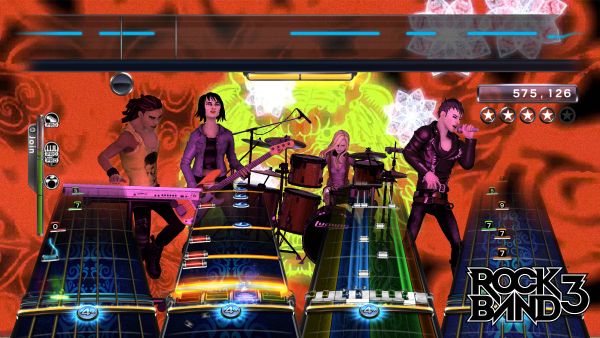
One change that I am not particularly fond of is the fact that each player creates his or her own band. During play, each separate band earns fans, unlocks vehicles like the van or the airplane, etc. I suppose this was implemented to appease groups who don’t always play together, but I think it detracts somewhat from the cooperative feel. When everyone is in the same band, reaching goals together means a whole lot more than unlocking the van for the third time, for instance. Also, why doesn’t the crowd sing along with the band in Rock Band 3 songs? That was a favorite feature of mine and I am sure for others as well. These are minor quibbles, perhaps, but still irksome.
If Rock Band 3 were a disc only release, for standard drums, guitars, and vocals, it would still be a fine music game. The refinements to the interface work nicely, though there is still room for improvement in managing gamertags. The songs included are a great mix, and sorting through them has never been easier. The setlist and other improvements are easily worth the cost of the disc alone. However, the addition of keyboards and Pro Mode take Rock Band 3 to the next level of innovation in the music game genre.
The Rock Band 3 keyboard is wireless, and covers two octaves, with full-sized keys. It is shaped like a keytar, and comes with a strap to be used as such, but it works fine on a tabletop or even on your lap. The neck area has a touch sensitive strip that can be used for pitch bending effects, plus the overdrive button. The keyboard is divided into colored areas corresponding to the buttons on the guitar controller, from red to orange. Navigation buttons are above the keys, and there is a MIDI port available to connect the keyboard to a computer. The wireless unit feels sturdy and well-made.

The keyboard is another part to add to your Rock Band, allowing a fourth player before you add in vocals. There are two tiers of difficulty for keyboard, Pro and standard. Standard keys is very simple for music game veterans, only using five keys, each in a row. I was able to play standard keys on Expert after only two or three songs. Pro keys was quite a bit more difficult. The Pro note track is ten white notes wide, and is color coded to indicate which keys to use. White and black keys fall down the note track in a manner that is instantly familiar to Rock Band fans. On Easy and Medium Pro, the tracks don’t shift from one colored section to another, but on harder levels they do.
Easy Pro Keys was quite a step up in difficulty from standard Expert. Thankfully, there is an extensive tutorial, which is in depth and yet still accessible. It’s light on actual music theory, but in most other respects its a great way to develop keyboarding skills. You won’t be able to read standard piano music, but you will know hand placement and many other “nuts and bolts” keyboard skills. I wish I’d had Rock Band 3 when I was attempting to learn piano in college, that’s for sure.
Pro Mode isn’t just available for keyboard, though: guitar, bass, and drums get the additional tier of difficulty, as well as the trainers. Pro Drums requires a cymbal kit, and adds circles to the standard notes in the track to denote them. Pro Guitar and Bass require a special controller. One model, available now, is $150 and functions only as a Rock Band instrument. Next March, a “real guitar” with special sensors will be released, which can be used as a controller or plugged into a real amp, for $280. I have not had the chance to test either Pro Drums, Guitar, or Bass, but if Pro Keys is any indication, it will be a long-term challenge to master Pro Expert on any instrument. Pro modes are selectable when playing in a full band, just like the standard difficulty levels.